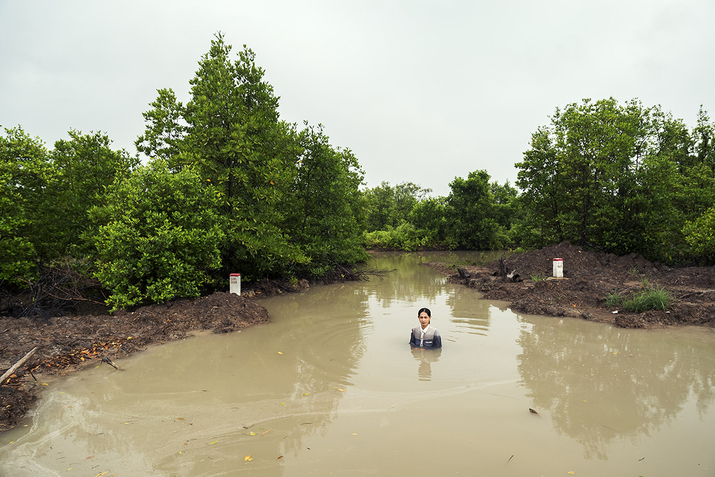-
From Current Issue
-
- Editor’s Letter Fire in the Heart
- Reviews I Gusti Ayu Kadek Murniasih
- Reviews 11th Seoul Mediacity Biennale: “One Escape at a Time”
- Dispatch Networked China
- One on One Monira Al Qadiri on Yukio Mishima
- Essays The rise of independent art spaces in pandemic-era Shanghai
- Features Tuan Andrew Nguyen
- Table of Contents
- Web Exclusives
- Archive
- Subscribe

R
E
V N
E
X
T
OH SOON-HWA, Fishing in the Rice Field, 2017, digital inkjet color print on photographic paper, 80 × 120 cm. Courtesy the artist and The Private Museum, Singapore.
From its headwaters in the Tibetan plateau, the Mekong River flows past six countries for over 4,000 kilometers to the South China Sea—but its journey is unquiet. Since the 1990s, the river has been punctuated by a string of Chinese hydropower dams, with dozens more in the works. Cambodia, Laos, Thailand and Vietnam are also constructing scores of large dams in the Mekong River Basin, with the promise of cheap electric power for the region.
At The Private Museum, photographer Oh Soon-Hwa contemplates not razed mountains or concrete walls, but the quiet, devastating transformations brought about by unchecked development. The dams, along with climate change, play havoc with the delta’s ecologies, inducing deforestation, unpredictable droughts and flooding, and surges of seawater into agricultural areas. In her solo exhibition, “Coastal Regions (Delta),” the Singapore-based photographer and educator presented 13 large digital color prints (all works 2017). Her imagery, documentarian in scope yet possessing an undefined melancholy, focuses on the southern Mekong River Delta in Vietnam, where the river has been integral to the region’s cultural and economic life for centuries.
Since 2005, Oh has explored the delta, and “Coastal Regions” is part of her ongoing series about this land and the resilience of its people. The shimmering tidal flats of Land Loss embody a portrait of inundated agricultural land, now given over to aquaculture and houses on stilts. The ostensibly bucolic Fishing in the Rice Field is an example of adaptation through necessity, as is A Shrimp Catcher in the Mangrove Swamp—the enigmatic study of an expressionless woman nearly submerged in opaque brown water, fully clothed.
Oh’s understated images appear straightforward but, accompanied by her succinct accompanying narratives, they take on vexed implications. The teenager in A Fisherman in the Tran De Estuary, and the painterly harbor scenario of Collecting Trash Fish each reflect the social and economic conflicts of water diversion and climate fluctuations. Oh offers insights through fragments taken from interviews and personal anecdotes: the government is urging a shift from rice-growing to fishing and aquaculture, because rising seas, erosion and use of soil to build roads are wiping out viable agricultural land—yet fish populations are dwindling. Fish-farming is problematic, owing to seasonal and tidal flooding; to counter these, dykes must be built. In Occasional Farmers, an elderly couple pose before their home; we read they are unaffected by flooding, thanks to a dyke that surrounds their entire province. Not so fortunate is a former rice farmer who now cultivates shrimp: in The Handmade Dyke, the man stands upon the thick greasy mud of his collapsed dyke. His weary dignity recalls American photographer Dorothea Lange’s portraits, taken during the Great Depression.
Oh traces these topographies of human-induced change through stripped-down imagery, often in serene palettes of browns and watery greys, rendering her occasional bursts of color and detail all the more powerful. Empty blue chairs queue hopefully along the breakfront of a bleak estuary; the emerald green of a hull, and the deep saturated blue of a ship’s trim hint at joy. In a work that recalls 17th-century genre paintings, The Meteorological Station is a concise vignette of a hydro-meteorological lab, where river water is tested. Bottles of samples and chemicals sit by a young, awkward chemist in this mannered scene of pale ivories and blues, animated with a vivid red-flowered cloth and delicate reflections of glass. The poised transparency in Oh’s works stems from her formalist leanings; the artist characterizes her practice as highly conceptual, in that she does not merely capture images with her camera, but has an active role in their creation.
In one past series, Oh has focused on Vietnamese “migrant brides” who marry foreigners to support their families; in another, she documented young Korean women working and studying in the United States. Without venturing into sentimentality, the artist observes their private milieus—a farmhouse, a kitchen—to elicit an intimate iconography of experience. With the same gaze, “Coastal Regions” distills light and land into a clear-eyed synopsis of imbalance.
Oh Soon-Hwa’s “Coastal Regions (Delta)” is on view at The Private Museum, Singapore, until May 14, 2017.
To read more of ArtAsiaPacific’s articles, visit our Digital Library.








